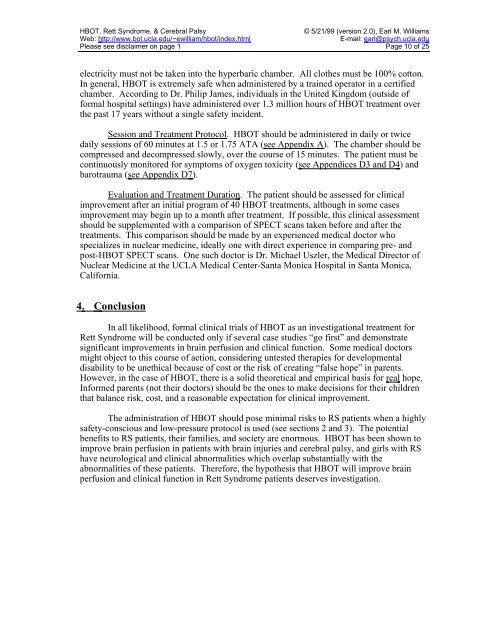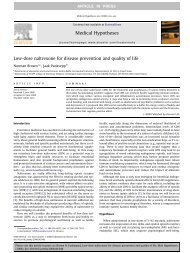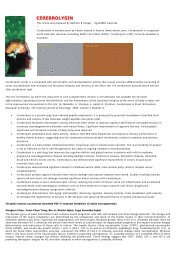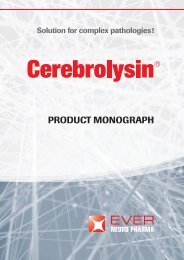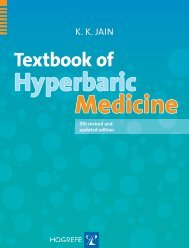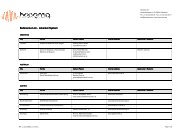Low-Pressure Hyperbaric Oxygen Therapy (HBOT) as an - HyperMED
Low-Pressure Hyperbaric Oxygen Therapy (HBOT) as an - HyperMED
Low-Pressure Hyperbaric Oxygen Therapy (HBOT) as an - HyperMED
You also want an ePaper? Increase the reach of your titles
YUMPU automatically turns print PDFs into web optimized ePapers that Google loves.
<strong>HBOT</strong>, Rett Syndrome, & Cerebral Palsy © 5/21/99 (version 2.0), Earl M. Williams<br />
Web: http://www.bol.ucla.edu/~ewilliam/hbot/index.html E-mail: earl@psych.ucla.edu<br />
Ple<strong>as</strong>e see disclaimer on page 1 Page 10 of 25<br />
electricity must not be taken into the hyperbaric chamber. All clothes must be 100% cotton.<br />
In general, <strong>HBOT</strong> is extremely safe when administered by a trained operator in a certified<br />
chamber. According to Dr. Philip James, individuals in the United Kingdom (outside of<br />
formal hospital settings) have administered over 1.3 million hours of <strong>HBOT</strong> treatment over<br />
the p<strong>as</strong>t 17 years without a single safety incident.<br />
Session <strong>an</strong>d Treatment Protocol . <strong>HBOT</strong> should be administered in daily or twice<br />
daily sessions of 60 minutes at 1.5 or 1.75 ATA ( see Appendix A ). The chamber should be<br />
compressed <strong>an</strong>d decompressed slowly, over the course of 15 minutes. The patient must be<br />
continuously monitored for symptoms of oxygen toxicity ( see Appendices D3 <strong>an</strong>d D4 ) <strong>an</strong>d<br />
barotrauma ( see Appendix D7 ).<br />
Evaluation <strong>an</strong>d Treatment Duration . The patient should be <strong>as</strong>sessed for clinical<br />
improvement after <strong>an</strong> initial program of 40 <strong>HBOT</strong> treatments, although in some c<strong>as</strong>es<br />
improvement may begin up to a month after treatment. If possible, this clinical <strong>as</strong>sessment<br />
should be supplemented with a comparison of SPECT sc<strong>an</strong>s taken before <strong>an</strong>d after the<br />
treatments. This comparison should be made by <strong>an</strong> experienced medical doctor who<br />
specializes in nuclear medicine, ideally one with direct experience in comparing pre- <strong>an</strong>d<br />
post-<strong>HBOT</strong> SPECT sc<strong>an</strong>s. One such doctor is Dr. Michael Uszler, the Medical Director of<br />
Nuclear Medicine at the UCLA Medical Center-S<strong>an</strong>ta Monica Hospital in S<strong>an</strong>ta Monica,<br />
California.<br />
4.<br />
Conclusion<br />
In all likelihood, formal clinical trials of <strong>HBOT</strong> <strong>as</strong> <strong>an</strong> investigational treatment for<br />
Rett Syndrome will be conducted only if several c<strong>as</strong>e studies “go first” <strong>an</strong>d demonstrate<br />
signific<strong>an</strong>t improvements in brain perfusion <strong>an</strong>d clinical function. Some medical doctors<br />
might object to this course of action, considering untested therapies for developmental<br />
disability to be unethical because of cost or the risk of creating “false hope” in parents.<br />
However, in the c<strong>as</strong>e of <strong>HBOT</strong>, there is a solid theoretical <strong>an</strong>d empirical b<strong>as</strong>is for real hope.<br />
Informed parents (not their doctors) should be the ones to make decisions for their children<br />
that bal<strong>an</strong>ce risk, cost, <strong>an</strong>d a re<strong>as</strong>onable expectation for clinical improvement.<br />
The administration of <strong>HBOT</strong> should pose minimal risks to RS patients when a highly<br />
safety-conscious <strong>an</strong>d low-pressure protocol is used (see sections 2 <strong>an</strong>d 3). The potential<br />
benefits to RS patients, their families, <strong>an</strong>d society are enormous. <strong>HBOT</strong> h<strong>as</strong> been shown to<br />
improve brain perfusion in patients with brain injuries <strong>an</strong>d cerebral palsy, <strong>an</strong>d girls with RS<br />
have neurological <strong>an</strong>d clinical abnormalities which overlap subst<strong>an</strong>tially with the<br />
abnormalities of these patients. Therefore, the hypothesis that <strong>HBOT</strong> will improve brain<br />
perfusion <strong>an</strong>d clinical function in Rett Syndrome patients deserves investigation.


